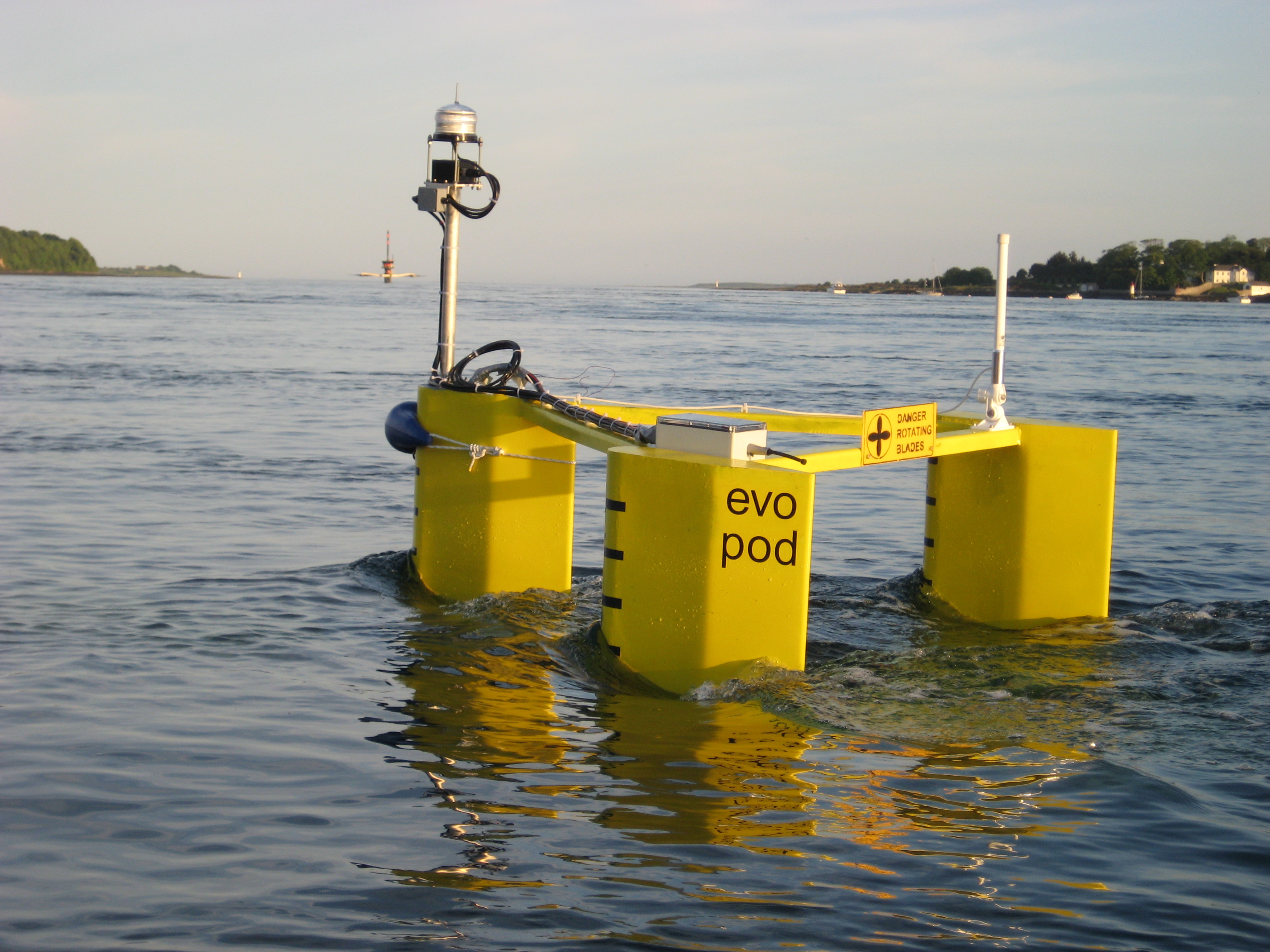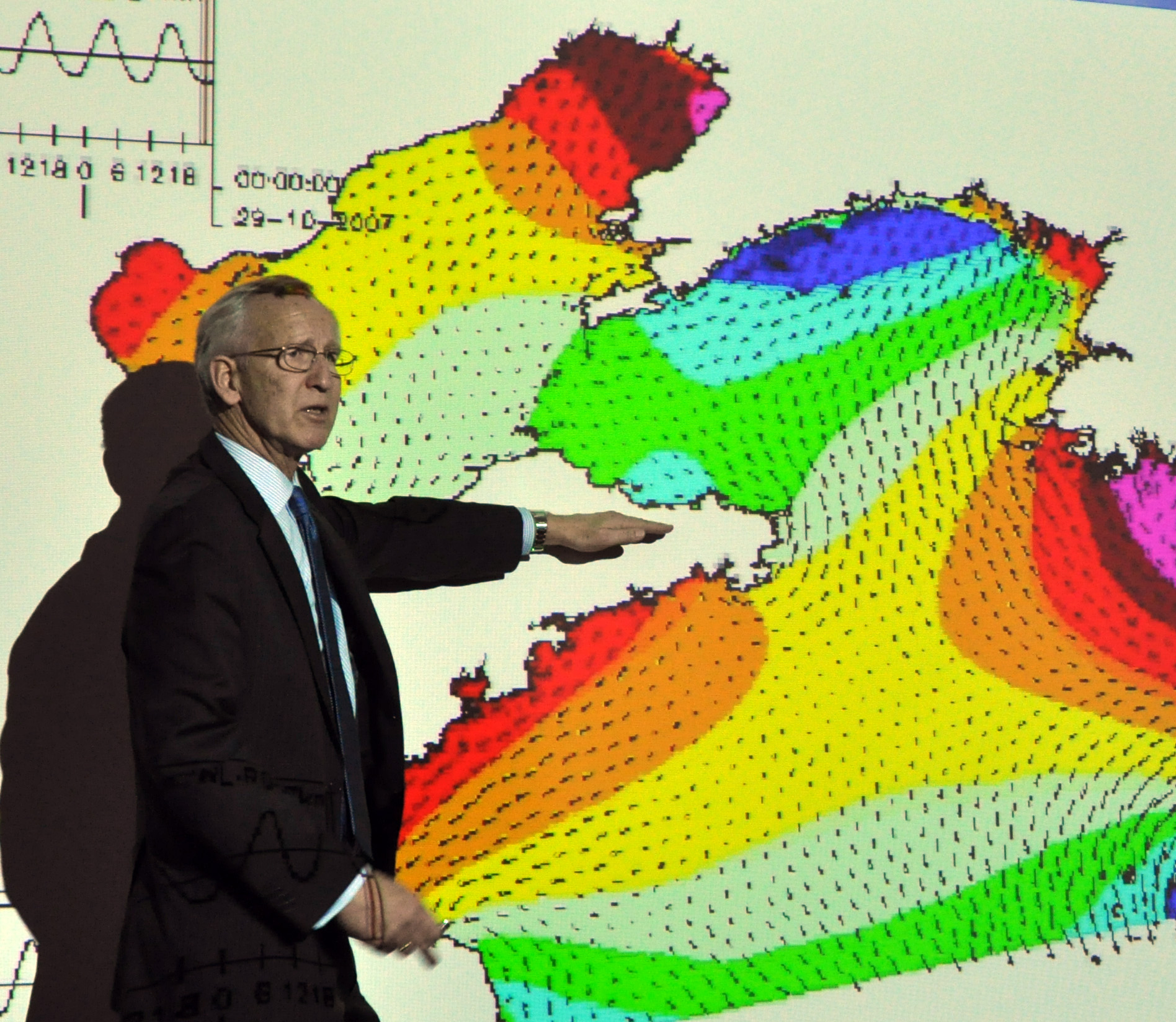|
Marine Energy
Marine energy, also known as ocean energy, ocean power, or marine and hydrokinetic energy, refers to energy harnessed from waves, tides, salinity gradients, and temperature differences in the ocean. The movement of water in the world's oceans stores vast amounts of kinetic energy, which can be converted into electricity to power homes, transportation, and industries. Marine energy includes wave power, which is derived from surface waves, and tidal power, which is obtained from the kinetic energy of moving water. Offshore wind power, however, is not considered marine energy because it is generated from wind, even if the wind turbines are located over water. The oceans have a tremendous amount of energy and are close to many if not most concentrated populations. Ocean energy has the potential of providing a substantial amount of new renewable energy around the world. While marine energy is a sustainable alternative to fossil fuels, its development can impact marine ecosystems, w ... [...More Info...] [...Related Items...] OR: [Wikipedia] [Google] [Baidu] [Amazon] |
Kinetic Energy
In physics, the kinetic energy of an object is the form of energy that it possesses due to its motion. In classical mechanics, the kinetic energy of a non-rotating object of mass ''m'' traveling at a speed ''v'' is \fracmv^2.Resnick, Robert and Halliday, David (1960) ''Physics'', Section 7-5, Wiley International Edition The kinetic energy of an object is equal to the work, or force ( F) in the direction of motion times its displacement ( s), needed to accelerate the object from rest to its given speed. The same amount of work is done by the object when decelerating from its current speed to a state of rest. The SI unit of energy is the joule, while the English unit of energy is the foot-pound. In relativistic mechanics, \fracmv^2 is a good approximation of kinetic energy only when ''v'' is much less than the speed of light. History and etymology The adjective ''kinetic'' has its roots in the Greek word κίνησις ''kinesis'', meaning "motion". The dichoto ... [...More Info...] [...Related Items...] OR: [Wikipedia] [Google] [Baidu] [Amazon] |
Tidal Stream Generator
A tidal stream generator, often referred to as a tidal energy converter (TEC), is a machine that extracts energy from moving masses of water, in particular tides, although the term is often used in reference to machines designed to extract energy from the run of a river or tidal estuarine sites. Certain types of these machines function very much like underwater wind turbines and are thus often referred to as tidal turbines. They were first conceived in the 1970s during the oil crisis.Jones, Anthony T., and Adam Westwood. "Power from the oceans: wind energy industries are growing, and as we look for alternative power sources, the growth potential is through the roof. Two industry watchers take a look at generating energy from wind and wave action and the potential to alter." The Futurist 39.1 (2005): 37(5). GALE Expanded Academic ASAP. Web. 8 October 2009. Tidal stream generators are the cheapest and least ecologically damaging among the four main forms of tidal power generation. ... [...More Info...] [...Related Items...] OR: [Wikipedia] [Google] [Baidu] [Amazon] |
Point Absorber Buoy
Wave power is the capture of energy of wind waves to do useful work – for example, electricity generation, desalination, or pumping water. A machine that exploits wave power is a wave energy converter (WEC). Waves are generated primarily by wind passing over the sea's surface and also by tidal forces, temperature variations, and other factors. As long as the waves propagate slower than the wind speed just above, energy is transferred from the wind to the waves. Air pressure differences between the windward and leeward sides of a wave crest and surface friction from the wind cause shear stress and wave growth. Wave power as a descriptive term is different from tidal power, which seeks to primarily capture the energy of the current caused by the gravitational pull of the Sun and Moon. However, wave power and tidal power are not fundamentally distinct and have significant cross-over in technology and implementation. Other forces can create currents, including breaking waves, win ... [...More Info...] [...Related Items...] OR: [Wikipedia] [Google] [Baidu] [Amazon] |
Dynamic Tidal Power
Dynamic tidal power or DTP is an untried but promising technology for tidal power generation. It would involve creating a long dam-like structure perpendicular to the coast, with the option for a coast-parallel barrier at the far end, forming a large 'T' shape. This long T-dam would interfere with coast-parallel tidal wave hydrodynamics, creating water level differences on opposite sides of the barrier which drive a series of bi-directional turbines installed in the dam. Oscillating tidal waves which run along the coasts of continental shelves, containing powerful hydraulic currents, are common in ''e.g.'' China, Korea, and the UK. The concept was invented and patented in 1997 by Dutch coastal engineers Kees Hulsbergen and Rob Steijn. A short video explaining the concept was completed in October 2013 and made available in English on YouTube and in Chinese on Youku. Description A DTP dam is a long barrier of 30 km or more which is built perpendicular to the coast, runnin ... [...More Info...] [...Related Items...] OR: [Wikipedia] [Google] [Baidu] [Amazon] |
Tidal Barrage Power
Tidal power or tidal energy is harnessed by converting energy from tides into useful forms of power, mainly electricity using various methods. Although not yet widely used, tidal energy has the potential for future electricity generation. Tides are more predictable than the wind and the sun. Among sources of renewable energy, tidal energy has traditionally suffered from relatively high cost and limited availability of sites with sufficiently high tidal ranges or flow velocities, thus constricting its total availability. However many recent technological developments and improvements, both in design (e.g. dynamic tidal power, tidal lagoons) and turbine technology (e.g. new axial turbines, cross flow turbines), indicate that the total availability of tidal power may be much higher than previously assumed and that economic and environmental costs may be brought down to competitive levels. Historically, tide mills have been used both in Europe and on the Atlantic coast of No ... [...More Info...] [...Related Items...] OR: [Wikipedia] [Google] [Baidu] [Amazon] |
Tidal Stream Power
A tidal stream generator, often referred to as a tidal energy converter (TEC), is a machine that extracts energy from moving masses of water, in particular tides, although the term is often used in reference to machines designed to extract energy from the run of a river or tidal estuarine sites. Certain types of these machines function very much like underwater wind turbines and are thus often referred to as tidal turbines. They were first conceived in the 1970s during the oil crisis.Jones, Anthony T., and Adam Westwood. "Power from the oceans: wind energy industries are growing, and as we look for alternative power sources, the growth potential is through the roof. Two industry watchers take a look at generating energy from wind and wave action and the potential to alter." The Futurist 39.1 (2005): 37(5). GALE Expanded Academic ASAP. Web. 8 October 2009. Tidal stream generators are the cheapest and least ecologically damaging among the four main forms of tidal power generation. ... [...More Info...] [...Related Items...] OR: [Wikipedia] [Google] [Baidu] [Amazon] |
Hydroelectricity
Hydroelectricity, or hydroelectric power, is Electricity generation, electricity generated from hydropower (water power). Hydropower supplies 15% of the world's electricity, almost 4,210 TWh in 2023, which is more than all other Renewable energy, renewable sources combined and also more than nuclear power. Hydropower can provide large amounts of Low-carbon power, low-carbon electricity on demand, making it a key element for creating secure and clean electricity supply systems. A hydroelectric power station that has a dam and reservoir is a flexible source, since the amount of electricity produced can be increased or decreased in seconds or minutes in response to varying electricity demand. Once a hydroelectric complex is constructed, it produces no direct waste, and almost always emits considerably less greenhouse gas than fossil fuel-powered energy plants. [...More Info...] [...Related Items...] OR: [Wikipedia] [Google] [Baidu] [Amazon] |
Desalinization
Desalination is a process that removes mineral components from saline water. More generally, desalination is the removal of salts and minerals from a substance. One example is soil desalination. This is important for agriculture. It is possible to desalinate saltwater, especially sea water, to produce water for human consumption or irrigation. The by-product of the desalination process is brine. Many seagoing ships and submarines use desalination. Modern interest in desalination mostly focuses on cost-effective provision of fresh water for human use. Along with recycled wastewater, it is one of the few water resources independent of rainfall. Due to its energy consumption, desalinating sea water is generally more costly than fresh water from surface water or groundwater, water recycling and water conservation; however, these alternatives are not always available and depletion of reserves is a critical problem worldwide. Desalination processes are using either thermal methods (i ... [...More Info...] [...Related Items...] OR: [Wikipedia] [Google] [Baidu] [Amazon] |
Tropics
The tropics are the regions of Earth surrounding the equator, where the sun may shine directly overhead. This contrasts with the temperate or polar regions of Earth, where the Sun can never be directly overhead. This is because of Earth's axial tilt; the width of the tropics (in latitude) is twice the tilt. The tropics are also referred to as the tropical zone and the torrid zone (see geographical zone). Due to the overhead sun, the tropics receive the most solar energy over the course of the year, and consequently have the highest temperatures on the planet. Even when not directly overhead, the sun is still close to overhead throughout the year, therefore the tropics also have the lowest seasonal variation on the planet; "winter" and "summer" lose their temperature contrast. Instead, seasons are more commonly divided by precipitation variations than by temperature variations. The tropics maintain wide diversity of local climates, such as rain forests, monsoons, sa ... [...More Info...] [...Related Items...] OR: [Wikipedia] [Google] [Baidu] [Amazon] |
Farfield Environment
Farfield is one of the seven boarding houses at Gresham's, an English public school at Holt, Norfolk. Farfield is currently home to approximately fifty boys. History and traditions Farfield was the third new boarding house to be built at the school, following its move from the town centre to the Cromer Road at the beginning of the 20th century, in a surge of renewal and expansion at Gresham's led by George Howson. Completed in 1911, it was shortly followed by a new school chapel. The first housemaster, Major J. C. Miller, and boys were transferred from a smaller house called Bengal Lodge.Farfield House Archive greshams.com, accessed 15 December 2022 The school magazine noted that a useful donkey was being kept in an outbuilding at Farfield. The young |
Climate
Climate is the long-term weather pattern in a region, typically averaged over 30 years. More rigorously, it is the mean and variability of meteorological variables over a time spanning from months to millions of years. Some of the meteorological variables that are commonly measured are temperature, humidity, atmospheric pressure, wind, and precipitation. In a broader sense, climate is the state of the components of the climate system, including the atmosphere, hydrosphere, cryosphere, lithosphere and biosphere and the interactions between them. The climate of a location is affected by its latitude, longitude, terrain, altitude, land use and nearby water bodies and their currents. Climates can be classified according to the average and typical variables, most commonly temperature and precipitation. The most widely used classification scheme is the Köppen climate classification. The Thornthwaite system, in use since 1948, incorporates evapotranspiration along ... [...More Info...] [...Related Items...] OR: [Wikipedia] [Google] [Baidu] [Amazon] |






